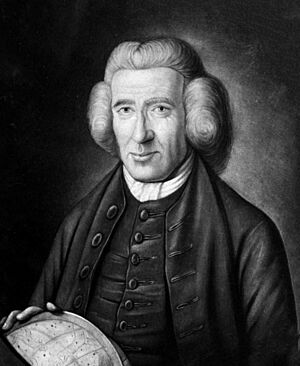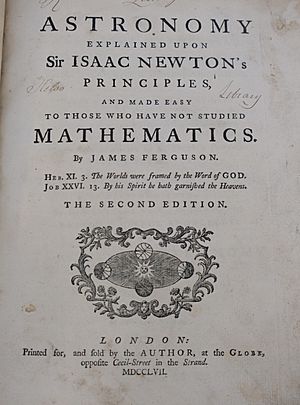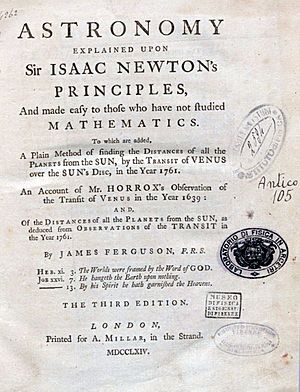James Ferguson (Scottish astronomer) facts for kids
James Ferguson (born April 25, 1710 – died November 17, 1776) was a Scottish astronomer. He was famous for inventing and improving tools for studying space. He was also a great example of someone who taught himself everything he knew. Ferguson traveled around, giving lectures to many people.
Contents
Early Life and Learning
Ferguson was born in a small village near Rothiemay in Banffshire, Scotland. His parents were not wealthy. He learned to read by listening to his father teach his older brother. An old woman also helped him read well before his father even started teaching him.
After his father taught him to write, he went to grammar school for just three months. This was all the formal education he ever received.
Discovering Mechanics
Ferguson became interested in how things work when he was young. He saw his father use a lever to lift part of their house roof. This simple act amazed him and sparked his curiosity.
In 1720, he worked as a shepherd on a nearby farm. He spent his free time building models of machines. At night, he would look up at the stars and study them. Later, he worked for a miller and then a doctor. These jobs were hard and made him quite weak.
When he had to return home due to his health, he made a clock. It had wooden wheels and a spring made from whalebone. A kind gentleman saw his inventions and hired him to clean clocks. This gentleman also let Ferguson live in his home.
Ferguson then started drawing patterns for needlework. He was so good at it that he thought about becoming a painter.
Moving to the City
In 1734, Ferguson moved to Edinburgh, a big city in Scotland. There, he began painting tiny portraits. This work helped him earn money to support himself and his family. He continued his scientific studies at the same time.
Later, he moved to Inverness. Here, he created his Astronomical Rotula. This was a special tool that showed the movements of planets, the sun, and the moon.
Life in London
In 1743, Ferguson moved to London, England. This became his home for the rest of his life. He wrote many important papers for the Royal Society of London. He became a member of this famous scientific group in November 1763.
Ferguson designed many models for astronomy and mechanics. These included globes of the Earth and sky. His globes were inspired by earlier ones made by John Senex. Ferguson even designed his own small pocket globe.
Public Lectures and Influence
In 1748, Ferguson started giving public lectures. He taught about "experimental philosophy," which was like science experiments. He gave these talks in many major towns across England.
A famous London bookseller, Andrew Millar, helped arrange his lectures. Ferguson was deeply interested in his subjects. He explained things clearly and used clever diagrams. He also had special machines to show how things worked. This made him one of the most popular science lecturers of his time.
Ferguson was known for inventing and improving scientific tools. He was also a great example of someone who learned everything on his own. Because of this, he is considered one of Scotland's most remarkable scientists.
In his later years, he received a yearly payment from the government. James Ferguson passed away in London on November 17, 1776. He was buried in St Marylebone churchyard.
Ferguson's Legacy
Even though he is not as well-known today, Ferguson was very important in his own time. Thomas Paine, a famous writer, mentioned him in his book "The Age of Reason." William Herschel, a famous astronomer, learned about space from Ferguson's books.
His reputation was so strong that he was chosen to join the American Philosophical Society in 1770. A German physicist, Georg Christoph Lichtenberg, admired Ferguson greatly. He said that Ferguson did "Everything... by experiments."
Major Works
Here are some of James Ferguson's most important books:
- Astronomical Tables (published in 1763)
- Lectures on Select Subjects (first published in 1760)
- Astronomy explained upon Sir Isaac Newton's Principles (published in 1756)
- Select Mechanical Exercises, with a Short Account of the Life of the Author, written by himself (published in 1773).
- Introduction to Electricity (first published in 1770)
His own story of his life is included in a book called Life by E. Henderson. This book also describes Ferguson's main inventions with pictures.
Images for kids








